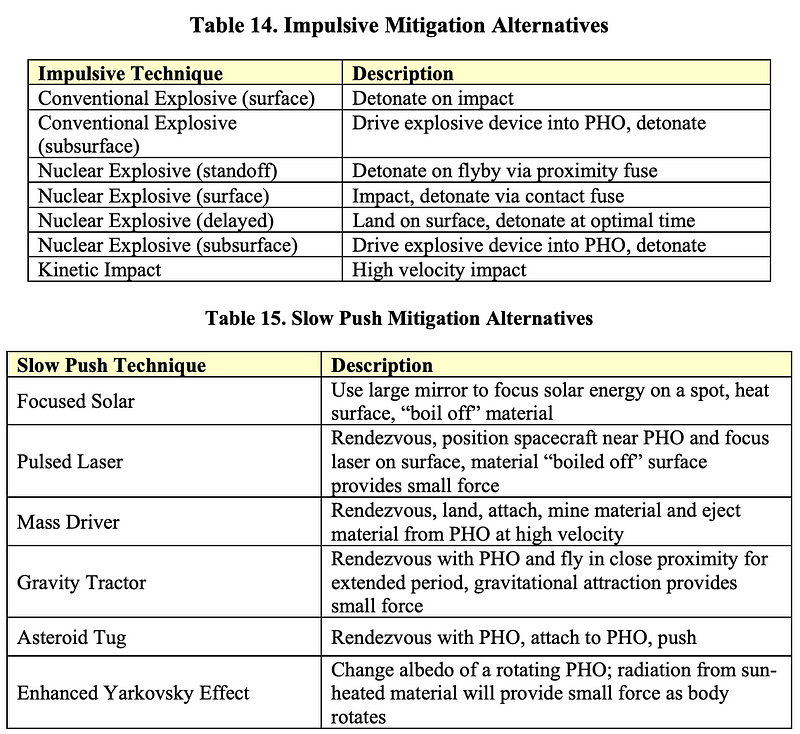NASA's Strategies for Asteroid Deflection: Reality vs. Fiction
Written on
Chapter 1: The Asteroid Threat
Picture this: a colossal asteroid is racing toward Earth. The consequences of such a collision would be catastrophic, potentially resulting in global extinction and the obliteration of humanity. This dramatic scenario is a staple of cinematic storytelling. Some films depict successful interventions; others portray an apocalyptic outcome.
But if faced with this situation in reality, do we possess the means to thwart an incoming asteroid? NASA has delved into this very question. In 2007, the agency released a comprehensive 28-page report outlining potential solutions for dealing with near-Earth objects (NEOs). For those interested, the entire report is accessible online.
Now, let’s compare the fictional methods frequently seen in movies with the insights provided by NASA’s research.
Section 1.1: Media Portrayals of NEO Encounters
Asteroids threatening Earth — it seems almost familiar, right? This trope has been explored in various narratives:
- In Michael Bay's Armageddon, a team of blue-collar drillers is sent to space to plant explosives on an asteroid.
- Arthur C. Clarke's The Hammer of God illustrates humanity's struggle to prevent a future asteroid impact, showcasing human error amidst advanced technology.
- Netflix’s Don’t Look Up depicts a scenario where an incoming asteroid is ignored due to political infighting and corporate greed.
Across these stories, two primary methods are typically proposed to avert an asteroid's impact:
- Explosive Disruption: Utilizing explosives, especially nuclear devices, to fragment the asteroid into smaller pieces.
- Kinetic Deflection: Employing a spacecraft to collide with the asteroid, altering its trajectory.
NASA articulates these strategies in detailed tables:

Section 1.2: The Importance of Early Detection
So, how effective are these methods? According to NASA's recent simulations, time is crucial. If an asteroid is detected mere months before impact, our chances of successfully diverting it are slim. We require several years of advance warning to assess vital information such as size, speed, trajectory, and composition.
Many asteroids resemble loose aggregates, which means that a nuclear explosion might scatter their fragments, increasing the likelihood that they would disintegrate harmlessly in the atmosphere. Understanding the asteroid's trajectory is also crucial, as a slight alteration in its speed could allow Earth to dodge a collision.
However, these avoidance tactics demand extensive preparation. Crafting a powerful nuclear device, for instance, is not a quick task. Furthermore, any spacecraft intended to attach to the asteroid for sustained thrust requires substantial time for design and launch.
NASA estimates that we need at least 5 to 10 years of advance notice to effectively counter a potential NEO threat. Currently, we have identified and tracked approximately 40% of the asteroids that could pose a risk to Earth.
Chapter 2: Testing Our Capabilities
NASA has a plan to enhance our monitoring capabilities with the development of a robust space telescope called the NEO Surveyor. Unfortunately, it took over a decade for this project to receive funding and was only approved for the preliminary design phase in June 2021 — more than 15 years after the initial proposal.
In an exciting upcoming development, we will soon test our asteroid deflection capabilities. In September 2022, NASA plans to send a probe to collide with a near-Earth asteroid, aiming to determine if we can successfully alter its path. This mission, known as the Double Asteroid Redirection Test (DART), is targeting Didymos, a binary asteroid system.
Didymos consists of two bodies: the larger asteroid measures around 0.78 kilometers, while the smaller one, Dimorphos, is about 160 meters in diameter. DART was launched on November 24, 2021, and is on course to impact Dimorphos later this month. While the changes to the asteroid's orbit will be modest, this experiment will help us gauge the viability of such an approach for future threats.

Could We Really Stop an Incoming Asteroid?
If a perilous asteroid were on a collision course with Earth, could we avert disaster? The answer is complicated. We have several potential strategies at our disposal, varying in effectiveness based on the asteroid's characteristics and the warning time we receive.
However, these methods remain theoretical at this stage. We currently lack any immediate solutions and require a significant amount of time to prepare for a mission. Moreover, we need to enhance our tracking systems for the estimated 27,000+ near-Earth objects.
If asteroid fear keeps you up at night, consider advocating for increased funding for NASA. Engage with your local representatives to ensure our preparedness for such threats. Rest assured, though: the probability of a catastrophic asteroid impact is quite low, with estimates suggesting a chance of about 1 in 100 million — a reassuring statistic!
Did you catch Don’t Look Up? What were your impressions?
The first video, Can Humans Deflect an ASTEROID?, discusses the various methods humanity might employ to protect Earth from asteroid threats and the science behind them.
The second video, NASA Is Preparing for the Impact of an Asteroid: A New Study Shows That It Will Hit Earth..., explores NASA's current research and initiatives aimed at preventing asteroid collisions with our planet.